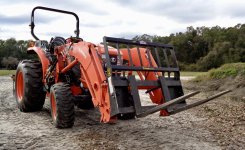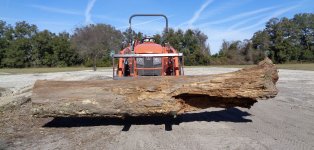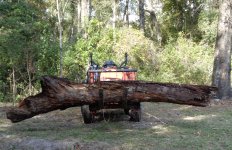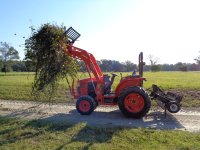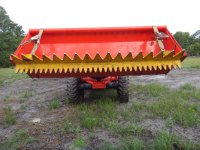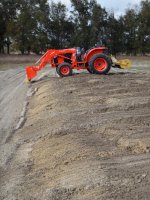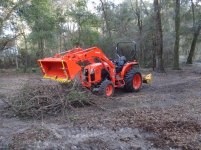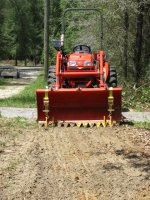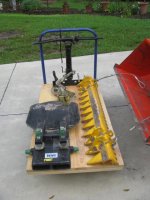jeff9366
Super Star Member
- Joined
- Jan 14, 2011
- Messages
- 12,787
- Tractor
- Kubota Tractor Loader L3560 HST+ ~~~~~~~~~~~~~ 3,700 pounds bare tractor, 5,400 pounds operating weight, 37 horsepower
beep chirp whirr
What am I trying to accomplish?
Loader tasks:
- snow removal at least the first lot, but ideally both (just the fel+bucket, or snowthrower?)
Disclosure: Florida person writing about snow removal.
Snowblowers are for deep snow. Snowblowers do not do well with 2" to 4" of snow.
If you need to clear a road, just one lane, get a front V-plow so you can clear snow rapidly in one or two passes.
VIDEO: tractor snow v-plow - YouTube
If you need to clear a rectangle use your FEL bucket, possibly with Snow Edge or Edge Tamer additions.
VIDEO: SNOW EDGE TRACTOR - YouTube
If you need to clear a rectangle and have regular >4" snowfall buy a SSQA Snow Pusher Bucket for your FEL.
VIDEO: Tractor Snow Pusher - YouTube
Other tractor applications:
- rehab then maintain existing paths through both forests (rotary cutter?)
Yes, a fairly heavy Rotary Cutter and a Ratchet Rake bucket attachment.
VIDEO: ratchet rake brush clearing - YouTube
DIRECT VENDER: Ratchet Rake, LLC - All Terrain Rake, Snow Edge, Tractor attachment, Bucket attachment, Loader, Skid loader, Kubota, Skid steer, Landscape rake, Brush remover, York Rake, Harley Rake, Rock Rake, Tractor rake attachment, Construction attachment, New Holland, Bobcat, Fire safety, Home fire safety, Fire prevention, John Deere, skid steer attachment, tractor implement
- help with forest maintenance/logging - trees die, the ability to lift/move trunks, haul wood, chip small branches, etc - thinking a lot about a grapple and a 3 point hitch chipper, for example
With less than five acres of concern a grapple is overkill in price and will be underused. Allocate grapple money to upgrade from a subcompact tractor to a compact tractor.
Consider 38" (short) SSQA Pallet Forks.
You can tow large trees using chain from the tree to the tractor rear/center drawbar.
LINK: https://www.tractorbynet.com/forums...rs-cross-drawbars-illuminated.html?highlight=
I owned a Wallenstein chipper. PTO chippers require too much maintenance beginning the second year of use. Burn tree debris if permissible.
- pick up the occasional light pallet and move it
Consider 38" (short) SSQA Pallet Forks.
- lift/move/redistribute earth to terrace a new section on the hill in the first lot.
- move mulch/dirt/rock/firewood/x/y/z from drop point (typically driveway) to where needed.
- handle graveling additional section(s) as needed
FEL bucket.
- handle regrading of the gravel driveway in the second lot
Ratchet Rake bucket attachment.
- lawn care for at least the first lot (mowing, annual aeration, etc)
Mid Mount Mower (MMM) ((expensive)) or Three Point Hitch Finish Mower. ((moderate cost))
VIDEO: Comparing Finish Mowers (midmount VS 3-point) - Kubota B26�1 - YouTube
What am I trying to accomplish?
Loader tasks:
- snow removal at least the first lot, but ideally both (just the fel+bucket, or snowthrower?)
Disclosure: Florida person writing about snow removal.
Snowblowers are for deep snow. Snowblowers do not do well with 2" to 4" of snow.
If you need to clear a road, just one lane, get a front V-plow so you can clear snow rapidly in one or two passes.
VIDEO: tractor snow v-plow - YouTube
If you need to clear a rectangle use your FEL bucket, possibly with Snow Edge or Edge Tamer additions.
VIDEO: SNOW EDGE TRACTOR - YouTube
If you need to clear a rectangle and have regular >4" snowfall buy a SSQA Snow Pusher Bucket for your FEL.
VIDEO: Tractor Snow Pusher - YouTube
Other tractor applications:
- rehab then maintain existing paths through both forests (rotary cutter?)
Yes, a fairly heavy Rotary Cutter and a Ratchet Rake bucket attachment.
VIDEO: ratchet rake brush clearing - YouTube
DIRECT VENDER: Ratchet Rake, LLC - All Terrain Rake, Snow Edge, Tractor attachment, Bucket attachment, Loader, Skid loader, Kubota, Skid steer, Landscape rake, Brush remover, York Rake, Harley Rake, Rock Rake, Tractor rake attachment, Construction attachment, New Holland, Bobcat, Fire safety, Home fire safety, Fire prevention, John Deere, skid steer attachment, tractor implement
- help with forest maintenance/logging - trees die, the ability to lift/move trunks, haul wood, chip small branches, etc - thinking a lot about a grapple and a 3 point hitch chipper, for example
With less than five acres of concern a grapple is overkill in price and will be underused. Allocate grapple money to upgrade from a subcompact tractor to a compact tractor.
Consider 38" (short) SSQA Pallet Forks.
You can tow large trees using chain from the tree to the tractor rear/center drawbar.
LINK: https://www.tractorbynet.com/forums...rs-cross-drawbars-illuminated.html?highlight=
I owned a Wallenstein chipper. PTO chippers require too much maintenance beginning the second year of use. Burn tree debris if permissible.
- pick up the occasional light pallet and move it
Consider 38" (short) SSQA Pallet Forks.
- lift/move/redistribute earth to terrace a new section on the hill in the first lot.
- move mulch/dirt/rock/firewood/x/y/z from drop point (typically driveway) to where needed.
- handle graveling additional section(s) as needed
FEL bucket.
- handle regrading of the gravel driveway in the second lot
Ratchet Rake bucket attachment.
- lawn care for at least the first lot (mowing, annual aeration, etc)
Mid Mount Mower (MMM) ((expensive)) or Three Point Hitch Finish Mower. ((moderate cost))
VIDEO: Comparing Finish Mowers (midmount VS 3-point) - Kubota B26�1 - YouTube
Last edited:
